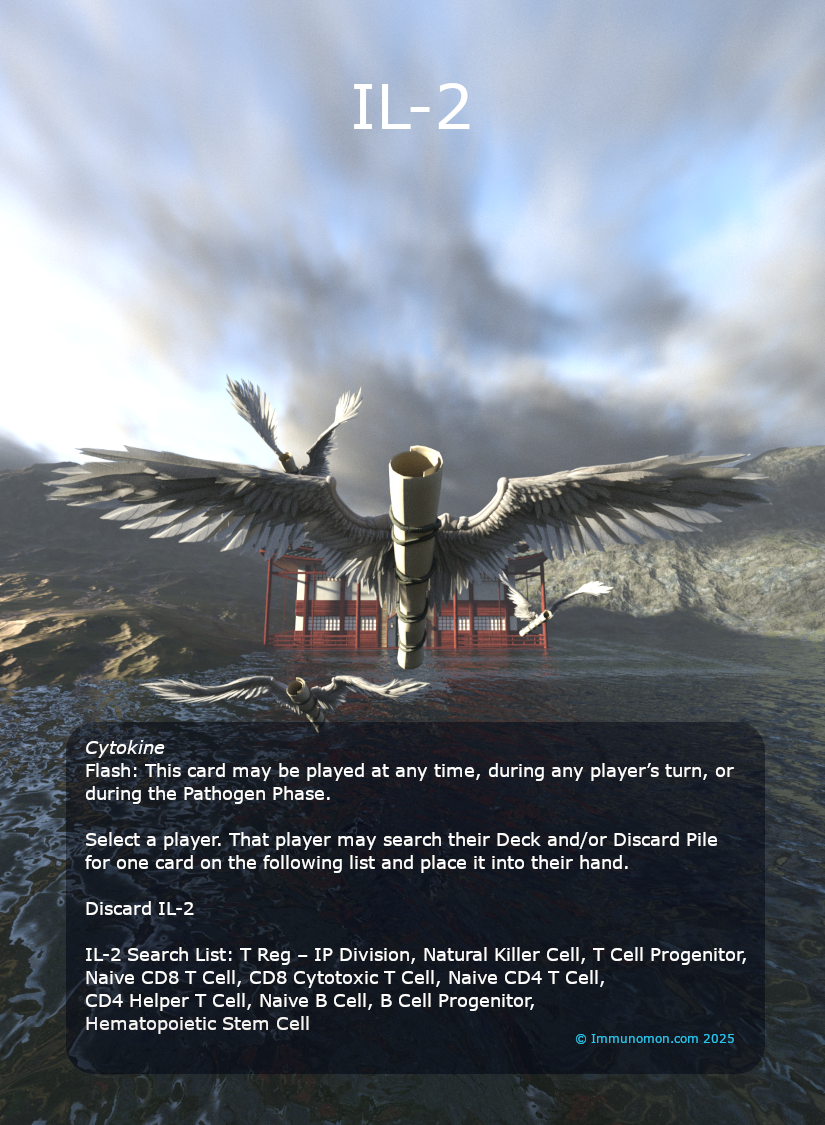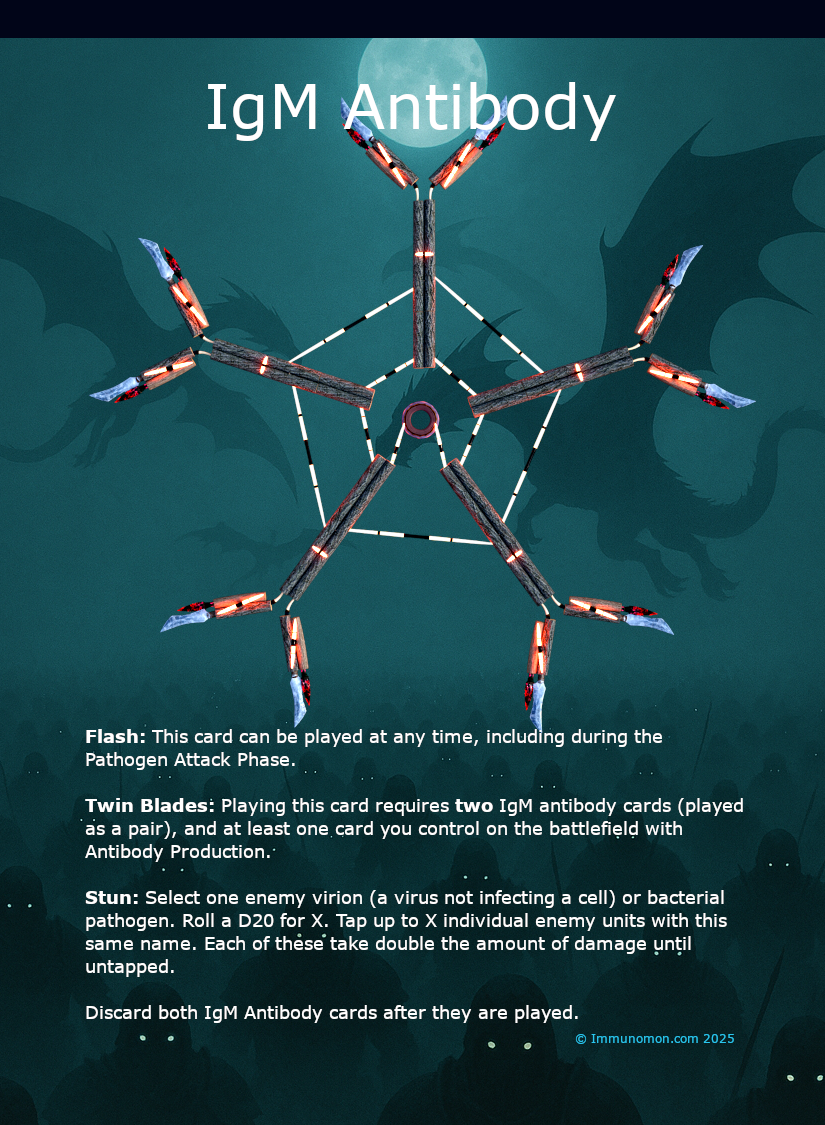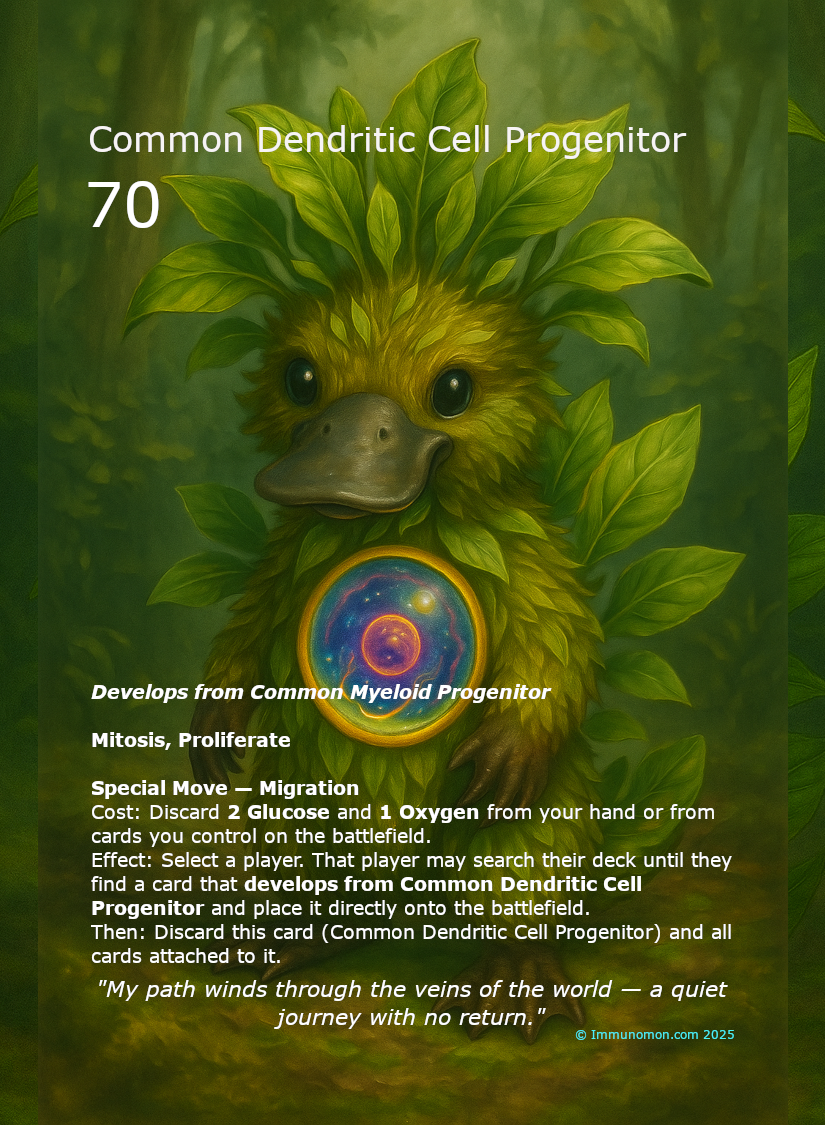
Welcome to Soma!
Immunomon Suggested Rules
The following rules are meant to be a guide in playing the Immunomon Trading Card Game. Yet, I (Greg, the creator of Immunomon) envision this as a game where rules can be changed, with the agreement of all players, different "house rules" can be embraced, and different scenarios can be tested.
Before explaining all of the rules, I think it's important to explain the purpose of Immunomon, beyond just another trading card game.
Background
My vision for this game is one in which all players work together to defeat diseases that plague our world. This is why I worked hard to make sure each card represented real-world biology and each available move accurately reflected the role of the real-world counterpart for each immune cell.
To be clear, I am not an Immunologist, nor do I pretend to be. My specialty is in molecular biology and bioinformatics. While I am striving for accuracy, part of the difficulty of immunology is that sometimes developmental pathways and distinctions between cell types can be unclear, even in the professional literature. The various types of dendritic cells present the strongest difficulty when it comes to background research, because so often they are simply referred to as "dendritic cells" - yet with different developmental pathways, and subtly different roles in the body. For the purposes of Immunomon, I gave different names to the 5 main groups of dendritic cells that I was able to include, noting subtle distinctions in the character names.
Of course, at the end of the day, no science game can be perfect, and even textbooks will always have to be edited and updated as new information comes in and as accuracy is refined.
Before explaining all of the rules, I think it's important to explain the purpose of Immunomon, beyond just another trading card game.
Background
My vision for this game is one in which all players work together to defeat diseases that plague our world. This is why I worked hard to make sure each card represented real-world biology and each available move accurately reflected the role of the real-world counterpart for each immune cell.
To be clear, I am not an Immunologist, nor do I pretend to be. My specialty is in molecular biology and bioinformatics. While I am striving for accuracy, part of the difficulty of immunology is that sometimes developmental pathways and distinctions between cell types can be unclear, even in the professional literature. The various types of dendritic cells present the strongest difficulty when it comes to background research, because so often they are simply referred to as "dendritic cells" - yet with different developmental pathways, and subtly different roles in the body. For the purposes of Immunomon, I gave different names to the 5 main groups of dendritic cells that I was able to include, noting subtle distinctions in the character names.
Of course, at the end of the day, no science game can be perfect, and even textbooks will always have to be edited and updated as new information comes in and as accuracy is refined.
This is why I am seeking those who specialize in immunology to provide continued feedback on this project as it grows, and I am honored by those who have already offered their expertise. (Though I am responsible for any errors, including those that have no doubt been overlooked, a common problem with any textbook, or large-scale educational resource).
Hard Rules And House Rules
For this game, some hard rules must be put forth.
1.) Respect, respect, respect - All players must be respected in their human dignity during the entire course of a game meeting. A player who persists in unprovoked disrespect will be asked by the gamemaster and the other players to gather their cards and respectfully leave the game meeting.
2.) Pre-determined House Rules - Gameplay rules beyond the Hard Rules must be agreed to in advance by all players. This rule is inspired by the Senegalese tribal system, in which all members of a tribe must agree on a new proposed law before it can become an official, binding law. Rule of a dictator or by "mob rule" is not permitted, and any player may choose to leave the meeting at any time for any reason or no reason.
Players may agree, however, to change a scenario during the game if all players agree to this flexibility in advance. Keep in mind that the purpose of Immunomon is to play with hypothetical scenarios to see how we humans might work with the immune system in the real world to fight real diseases. If this means drawing 10 cards instead of 3, and creating a new type of vaccine against real-world cancers, then I hardly see an issue. Cancer and disease never play fair anyway.
Hard Rules And House Rules
For this game, some hard rules must be put forth.
1.) Respect, respect, respect - All players must be respected in their human dignity during the entire course of a game meeting. A player who persists in unprovoked disrespect will be asked by the gamemaster and the other players to gather their cards and respectfully leave the game meeting.
2.) Pre-determined House Rules - Gameplay rules beyond the Hard Rules must be agreed to in advance by all players. This rule is inspired by the Senegalese tribal system, in which all members of a tribe must agree on a new proposed law before it can become an official, binding law. Rule of a dictator or by "mob rule" is not permitted, and any player may choose to leave the meeting at any time for any reason or no reason.
Players may agree, however, to change a scenario during the game if all players agree to this flexibility in advance. Keep in mind that the purpose of Immunomon is to play with hypothetical scenarios to see how we humans might work with the immune system in the real world to fight real diseases. If this means drawing 10 cards instead of 3, and creating a new type of vaccine against real-world cancers, then I hardly see an issue. Cancer and disease never play fair anyway.
Setup
Shuffle – Place the Pathogen Deck and your Deck in their respective positions. Draw 20 cards. Pick a Player Number from 1–20 (this will be your number for the game). For multi-player games, it is suggested that each player chooses a different Player #. Set Player Health: Each player begins the game with 2,000 Health Points (HP). (House Rules or various expansion cards may change this number. For example, if players want to adjust the game to an easier mode, perhaps 10,000 Health Points to start with per player would be appropriate.)
Turn Structure
Phase 1 – Untap Phase 1. Untap all cards on the Battlefield. As with other trading card games, "tapped" means that the card is turned 90 degrees to the right, and "untapped" or "untapping" means that the card is turned back to the upright position. Phase 2 – Roll Phase 2. Roll a die (D20). 3. If a Pathogen number is rolled, play a card from the top of the Pathogen Deck (it enters play tapped by default ). Phase 3 – Draw Phase 4. Draw 3 cards . (Draw 7 cards if your player number was rolled.) Phase 4 – Main Phase 5. Do any of the following, in any order: a. Play cards from your hand. - Cards enter play tapped by default . b. Attack with cards on the battlefield. - Cards on the battlefield are tapped by default . c. Go on the offense. - Play a Pathogen Card when ready. It is suggested that players wait until they have built a substantial army to defend against the Pathogen Monsters before going on the offensive. Phase 5 – Shuffle Phase Shuffle any decks as required by card effects. This phase can be done at the end of the turn. Phase 6 – Pathogen Monster Attack Phase
Pathogen Activation -If a Pathogen number is rolled during Phase 2 , draw and immediately play the top card of the Pathogen Deck . Pathogen cards enter play tapped and cannot attack on the same turn they are played (unless a card ability says otherwise). Pathogen Attacks -On subsequent turns, untapped Pathogen cards may attack player armies or directly attack player HP (Attacks directly affect player Health Points, unless otherwise stated). Each Pathogen Monster has its own Attack Power (ATK) and Health Points (HP) as indicated on the card. Damage dealt to players reduces their 2,000 base HP . During multiplayer games, it is suggested that players are required to take damage from the Pathogen Monsters in a “roundtable” fashion. This means that each player, regardless of damage already taken, takes turns receiving all of the damage from the Pathogen Monsters during that turn. Players, therefore, have the potential to be killed by the Pathogen Monster army as it attacks. So Player 1 may receive damage one turn, while Player 2 takes damage on the next, followed by Player 3, and then on the fourth turn Player 1 takes the damage again.
Player Victory: Players win by defeating all active Pathogen Monsters and clearing the Pathogen Deck . Pathogens may be attacked as they are played by rolling the D20 during Phase 2, or by going on the offensive once players think they are ready to attack the Pathogen Deck directly. Pathogen Victory: The Pathogens win if all players’ HP is reduced to 0 or below . When a player’s HP reaches 0, that player is considered defeated , and their army can no longer attack or defend.








